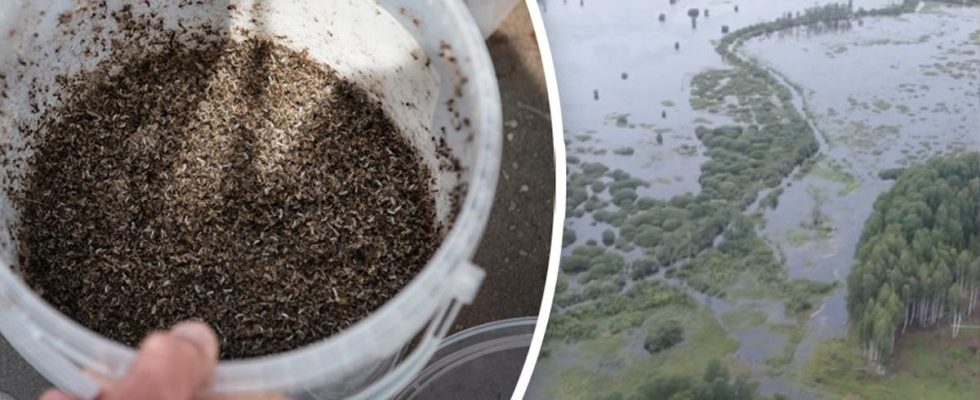Updated 14:31 | Published at 2:27 p.m
Floods and a rainy summer have produced mosquito records in the lower Dalälven.
But it could be much worse – all it takes is a warm evening.
– Then we don’t have much to look forward to, then I think you should be somewhere else for the next few months, says Jan Lundström, who fights mosquitoes.
It started with a flood last spring that took the mosquito repellents to bed.
– We have never experienced that before. The water usually goes up and then down like a pancake, so that we can fight the mosquito larvae. But now it rose considerably by several decimetres and covered completely new areas. We were promised a warm and dry summer like 2018 – kiss me back there, it didn’t happen, says Jan Lundström, director of operations at Nedab, which fights mosquitoes.
To stop the flooding mosquitoes at the lower Dalälven, they target the larvae. They lay out trays covered with small crystals – better known as Vectobac. When the larvae eat the crystals, a reaction is set in motion that ends with the stomach rupturing and the larva dying.
– When we target the larvae, it becomes extremely safe. It’s like organic surgery.
New areas
But when the floods became worse than usual, the larvae hatched in completely different places than they usually do.
– This is how we sit and cannot continue to fight. Our positions no longer match. Then we are forced to release a lot of larvae. They are in too deep water. It felt like a huge failure.
In addition, another flood came shortly after. The mosquito traps filled up quickly.
– It gave an enormous production. When we measured in areas where we do not control, we landed on 65,000 mosquitoes in one trap. We were back to the year 2000 when we started fighting mosquitoes. There have never been such amounts, it was unbelievable, says Jan Lundström.
To put it in perspective: 5,000 is considered a big mosquito problem and when 10,000 fit in a trap it is unbearable for humans.
End of Vectobac
But it got worse – the storm Hans moved in over the country and the summer rained away. Perfect weather for mosquitoes.
– It created a lot of puddles in areas where we do not have an extermination permit. We can’t handle that, I can’t even fathom how we’re going to be able to find all the puddles before it’s too late. Usually they breed in the large floodplains, this was completely new.
An accident rarely comes alone, soon it was time for another flood and Vectobacen – the pesticide – was almost finished. You had to cook according to the situation.
– We should have fought 4,000 hectares, but it was only 2,000. The water just stung. It was the biggest flood we had ever seen.
Fearing “mosquito disco”
Here we are now, several floods and rainstorms later. Mosquito larvae hatch all around the lower Dalälven.
– They lie there and simmer. Sometime around next week I think they will fly.
Now all hope is placed in the weather gods. The great horror is a warm evening.
– The female mosquitoes do not risk their lives trying to suck blood if they have not mated. So if they don’t have a lovely mosquito disco out there in the Dalälven on a warm, pleasant evening with high humidity, then there will be no mating. Then they don’t sting.
So what happens if it’s a warm evening and mosquito disco?
– Then we don’t have much to look forward to, then I think you should be somewhere else for the next few months.
This year, the mosquitoes will disappear when the frost comes, but mosquito invasions are something that will become more common in the future, Jan Lundström believes. Not just around the lower Dalälven.
– If you look at the climate projections, you expect that the autumns will be longer and warmer. What you will have to get used to is that they will start appearing in new places around the country. I think it has already established itself in new places this year that were not thought of before. Now it takes its chance to spread.
FACT What is Vectobac?
The mosquitoes at the lower Dalälven are fought by dumping Vectobac over selected areas by helicopter.
When the acute mosquito plague becomes too great, the biological control agent BTI is spread by helicopter on the flooded areas. BTI, Bacillus thuringiensis israelensis, is a bacterium in the biological control agent VectoBac G. The active ingredient is not the bacterium itself but a protein crystal which, when it enters the alkaline environment (high pH) in the gastrointestinal tract of the mosquito larvae, damages the intestine. The mosquito larvae eat the protein crystals, the intestine ruptures and the mosquito larvae die.
Source: Swedish Environmental Protection Agency
Read more
